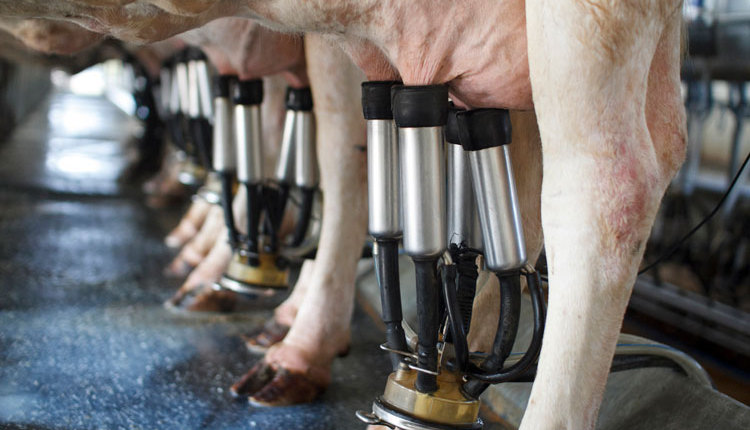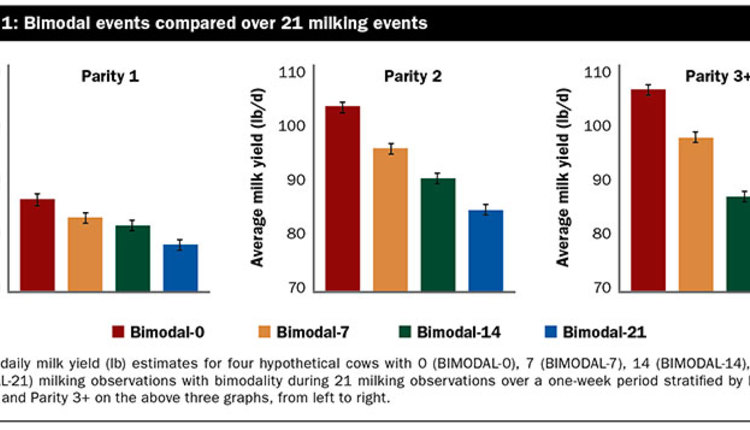The author is with Quality Milk Production Services at Cornell University’s College of Veterinary Medicine.
Delayed milk ejection — most often presented as a bimodal milk flow curve — occurs when the cisternal milk fraction is removed before the alveolar milk reaches the gland cistern. It is thought to occur due to a discrepancy between the intensity and the timing of premilking udder stimulation and the physiological requirements of the cow.
Bimodality has been associated with reduced milking efficiency, suppressed milk yield, and compromised udder health. Therefore, multiple research groups have studied the risk factors for bimodality and identified breed, stage of lactation, degree of udder filling, udder health status, and health events as factors associated with bimodality. In contrast, knowledge about the relationship between teat traits, such as teat shape, and the occurrence of bimodal milk flow curves is scarce.
Following milk flow
Traditionally, bimodal milk flow curves have been identified and evaluated by using portable electronic milk flow meters, which measure milk flow continuously during milking. More recently, the technology of on-farm milk flow meters has advanced significantly, and there has been an improvement in the accuracy of recording an individual cow’s milk flow characteristics.
Multiple electronic on-farm milk meters from different manufacturers are now capable of recording milk flow rates from 0 seconds to 15 seconds, 15 seconds to 30 seconds, 30 seconds to 60 seconds, and 60 seconds to 120 seconds. These incremental milk flow rates can be used to identify milk flow dynamics (including bimodality) of cows’ individual milking observations and provide real-time assessment of the milking performance of an entire herd.



Results from a recent study by our group showed that cows with flat teat ends had higher milk flow during the first two minutes of milking, suggesting that differences in the incremental milk flow rates and the occurrence of bimodality may exist among cows with different teat characteristics. Despite this evidence, the relationship between bimodality and teat characteristics (like teat shape) has not been investigated in depth. We therefore set out to study the relationship between teat shape and bimodality recorded with electronic on-farm milk flow meters.
To achieve our goal, we analyzed 220,928 milking observations collected from 2,520 cows from a single herd over a period of 31 days. Teat shape was visually assessed and classified into one of four categories (Figure 1):
- Triangular barrel and pointed teat end (TP)
- Square barrel and round teat end (SR)
- Square barrel, round teat end, and flat in the area of the teat orifice (SRF)
- Square barrel and flat teat end (SF)
We obtained cow-level milk flow rates with electronic on-farm milk flow meters. We defined a bimodal milk flow curve to be present if any of the incremental milk flow rates (flow rates during 15 seconds to 30 seconds, 30 seconds to 60 seconds, or 60 seconds to 120 seconds) were lower than any of the previous rates (flow rates during the first 15 seconds, 15 seconds to 30 seconds, or 30 seconds to 60 seconds).

Flat versus rounded
The frequency distribution of cows with different teat shapes was:
- TP: 96 (3.8%)
- SR: 1,751 (69.5%)
- SRF: 617 (24.5%)
- SF: 56 (2.2%)
Overall, we documented a bimodal milk flow curve in 62,307 out of the 220,928 cases. That was 28.2%, more than one quarter. Among cows with different teat shapes, the percentage of bimodal milk flow curves was 25.2% for cows with TP, 28.3% for cows with SR, 30.4% for cows with SRF, and 28.4% for cows with SF.
The statistical model revealed that teat shape was associated with the occurrence of bimodal milk flow curves. Compared with cows with SR teats, cows with TP teats had a lower risk of experiencing a bimodal milk flow curve, whereas cows with teats with SRF or SF had a higher risk of bimodality. Figure 2 shows the odds ratios for the occurrence of a bimodal milk flow curve, using cows with SR teats as a reference.
We attributed the relationship between teat shape and biomodality to the differences in milking speed across cows with different teat shapes. Teat shape may therefore serve as a useful phenotype to identify cows that are more likely to exhibit bimodality. We conclude that in the presented herd, bimodality is more likely to occur in cows with flat teat ends compared with those with round teat ends. This knowledge could allow farmers to employ targeted monitoring of these high-risk animals and develop management strategies to mitigate their risk.








